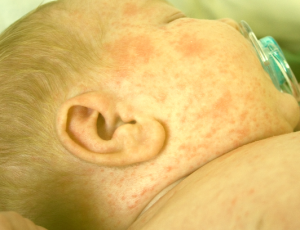Baby heat rash is a skin condition that results in blistering or lumps on the skin. The blisters can be itchy and may cause prickly feeling. It is more common among children and infants. During hot and humid weather condition, adults also get affected by baby heat rash. The baby heat rash is often referred to as prickly heat rash or Miliaria.
The blockage of sweat ducts causes the trapping of perspiration inside the surface of the skin. As a result baby heat rash can develop in the form of shallow blisters or reddish, deep lumps
Baby heat rash mostly disappears on its own. To solve this problem, the affected person should avoid the excessive collection of sweat and should maintain a low body and skin temperature. However, extreme cases of this condition may need medical treatment.
Symptoms of baby heat rash
For adults, baby heat rash affects the areas where the skin creases or where the skin brushes against clothing, leading to unnecessary friction. Most infants get affected by baby heat rash over their chest, neck, and shoulders. Other individuals may get affected in other regions of the body such as elbow folds, the groin and armpits.
Baby heat rash is of three kinds and each one has its specific signs, the types and symptoms of which are given below:
Miliaria crystalline-
- This type of baby heat rash is the mildest, and is most likely to affect the sweat glands or ducts present on the topmost layer of the skin.
- It results in the formation of clear, tiny and superficial blisters and sometimes forms small bumps which rupture easily.
- These blisters do not give pain or itching and vanishes on their own. There may be repeated cases of miliaria crystalline in hot and humid climate. Infants and babies are at greater risk to develop this type of baby heat rash than adults.
Miliaria rubra-
- It normally tends to occur deeper in skin and affect the sweat gland ducts of the outer layer of the skin or the epidermis. Adults exposed to hot and humid climate for longer periods or individuals subjected to hospitalization that involves prolonged periods of bedrest are at greater vulnerability to develop baby heat rash. Infants who are one to three weeks old can also get baby heat rash.
- The affected portion may get intense itching and prickly feeling.
- Red lumps may also develop in the affected parts of the body
- The affected portion may not perspire or may have minor sweating.
Miliaria profunda-
- Adults who had chronic cases of miliaria rubra normally get affected by this rare form of baby heat rash which occurs deeper inside the skin and tends to affect the dermis. Strenuous and excessive physical exercise leads to such type of baby heat rash.
- Such skin condition is followed by lesions which appear as goose pumps, are flesh-colored and thick.
- Minor sweating would result in and indicate the signs of heat exhaustion like hypertension, nausea, racy heart beats, dizziness and headaches.
The complications which may arise from baby heat rash are shown below:
- Inflammation of the bumps may happen due to infection of baby heat rash by bacteria and other germs. The signs of infection are oozing of pus from lesions or bumps, cold and fever, inflammation of lymph nodes in the neck, armpits, or groin. In addition, there may be increased redness and pain, swelling or warmth over the portion.
- If instances of heat exhaustion caused due to baby heat rash, are not treated promptly then it may lead to a heatstroke.
Causes of baby heat rash
The clogging of perspiration ducts is the primary cause of baby heat rash. The clogged ducts prevent the evaporation of sweat which is trapped beneath the skin leading to baby heat rash and inflammation of the skin.
Some of the reasons for clogging of the sweat ducts are discussed below:
- Infants are vulnerable because the ducts are not fully developed in newborns. This may cause the sweat to get trapped under the skin. Infants who are in incubators or wrapped in heavy woolens; have cases of high or are exposed to hot and humid weather are at greater risk to the rupture of sweat ducts, resulting in the development of baby heat rash
- Excessive exercise or physical activities leads to more sweating and causes the clogging of the ducts. This may result in the development of baby heat rash
- Extra use of ointment or creams may also block the skin pores.
- Hot and humid climate conditions
- The use of particular type of cloths or tight clothing also prevents the sweat evaporation
- Using heavy warm blankets or using electric heaters during winter may also cause baby heat rash
- Some drugs used to cure illness can also cause baby heat rash
- In rare cases, a prolonged hospitalization and bed rest can also cause baby heat rash
Baby heat rash treatment
- Limited exercise, loose clothing and staying indoors in AC would help the body get cool with lesser sweat which is best among treatment for baby heat rash
- Moderate cases of baby heat rash can be treated by topical medication to ease itching and prevent duct clogging
- The severest cases of baby heat rash can be treated by topical steroids
Baby heat rash pictures

